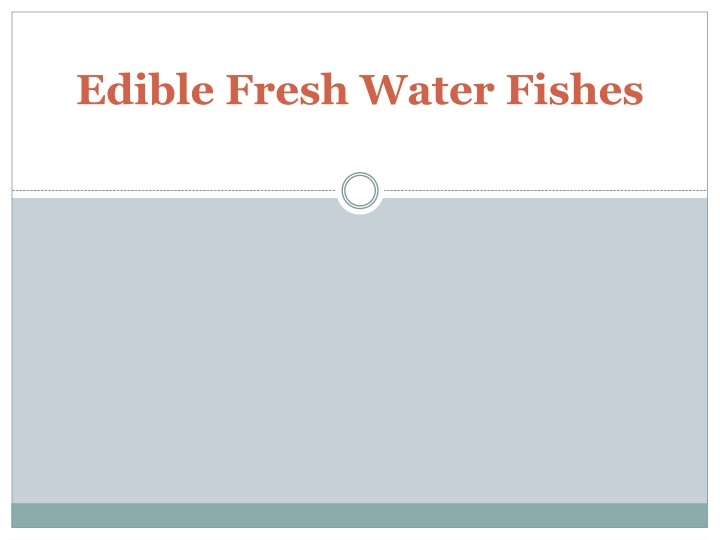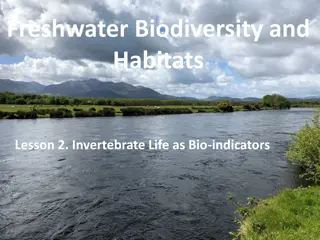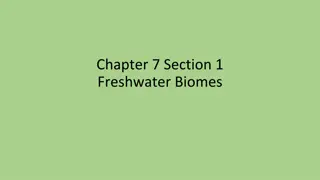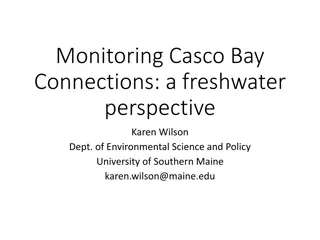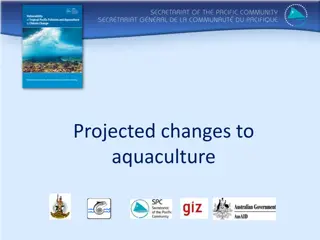Freshwater Edible Fishes: A Culinary Delight
Freshwater fishes are a valuable food source in tropical regions. With high protein content, essential nutrients, and great taste, popular varieties like Labeo Rohita, Catla Catla, and Cirrhinus Mrigala offer a delicious and nutritious culinary experience. Learn about their characteristics, breeding habits, and nutritional benefits in this informative guide.
Download Presentation

Please find below an Image/Link to download the presentation.
The content on the website is provided AS IS for your information and personal use only. It may not be sold, licensed, or shared on other websites without obtaining consent from the author.If you encounter any issues during the download, it is possible that the publisher has removed the file from their server.
You are allowed to download the files provided on this website for personal or commercial use, subject to the condition that they are used lawfully. All files are the property of their respective owners.
The content on the website is provided AS IS for your information and personal use only. It may not be sold, licensed, or shared on other websites without obtaining consent from the author.
E N D
Presentation Transcript
Introduction Fresh water fishes provide valuable source of food supply to the people located in tropical regions Flesh of fish is highly perishable constituted by 60% to 80% water and 13 to 20% protein and some amount of fat. Flesh also contain phosphorus and vitamins. Flesh is supposed to be the only source of protein and fat which is pure and easily available.
Labeo rohita This is famous and very important carp. It has length of 90 centimeters. Body is elongated. One pair of barbels present. Fins are black and scales are spotted. It is pond and bottom feeder both and most suitable for pond culture.
It breeds in flooded river during monsoon period. The younger fries may feed on zooplankton, fleas etc but adults are found to be feed on bottom sand, mud, leaves and aquatic plants.
Catla catla This fish attains maximum length of about 180 cm but is suitable for food when when it is not more than 61 cm. The colour is greyish on the dorsal side while silvery on the lateral side. Fins are black and sometimes black also. Scales are small. Various feeds upon vegetarian and non vegetaraian diets.
It is one of the fastest growing fishes. The breeding season is from June to August.
Cirrhinus mrigala It is found in fresh water. The maximu, length attained by this carp is about 90 to 100 centimeters. The young ones have similar feeding habits as Catla and Rahu but fingerlings and adults feed on huge amount of decaying organisms. Major foods consists of sand , mud, algae and decaying vegetations.
The males attain maturity after one year. Breeding takes place in flooded rivers. The breeding season is during July and September.
Cat Fishes The cat fishes are provided with very small eyes and well developed barbels by which they make a good vision and find their way. This is why they are called cat fishes. They are of good nutritive value and utilise less quantity of oxygen so have more haemoglobin in the blood.
Mystus seenghala (Sykes) This fish is found in riverine system like Ganges and Yamuna and also inhabits small reservoirs. Its body is brownish. When matured, it attains a length of about 46 cm. They feed on some insects, larvae, crustaceans, aquatic weeds etc.
Its breed in river and ponds. The breeding season is from April to July. This fish is predatory on small carps, other fishes and prawns. It has weight of 11 kilogram.
Rita rita It measures about 7-20 cm in length. Body is grey coloured with light ventral parts. Teeth present in both the jaws. Some are villiform and few are molariformed. Mouth gap is wide and upper jaws is larger than the lower jaw. Lateral line well marked up to the tail end.
Pangasius pangasius This fish is widely distributed in big rivers. The body is elongated. It attains a maximum length of 122 cm. Body is silvery, grey along the back. Barbs, lips and all the fins are deep red coloured. Pangsa feeds partly upon young fishes i.e., mostly on carps but mostly on mollusc.
Channa punctatus This fish prefer to live in stagnant water. It has dark coloured cylindrical body. It measures about 30-35 cm. Its colour varies from habitat to habitat. Body is also stripped with dark bands. Barbels are present.
The major food of this fish is aquatic insects, micro organisms, small fishes, molluscs and shrimps. They are profilic breeder and development is much rapid.
Qualities of culturable fishes For profitable fish culture it is necessary to select such species of fish which can utilise the natural and artifical food to the maximum extent and grow rapidly to large size.
Some qualities are following : It should have a fast growth rate. It should be able to use the natural food of the pond efficiently, and artificial food to maximum advantage. It should be hardy and resistant to disease. It should be able to survive under temporary bad water conditions.
It must be a prolific beeder and easy to breed in ponds. It should not be predaceous and preferably herbivorous in habit. The flesh should be tasteful and with high nutritive value. Species that can be cultured together without competing with each other, for maximum utilisation of water.
Types of Fish Farming 1: Complete fish farming 2: Restricted fish farming 3: Extensive fish farming 4: Intensive fish farming
Complete fish farming: The complete production of eggs and culminates in the formation of full size fishes, which may be utilized as food for marketing or as breeding stocks. fish farming begins with the
Restricted fish farming: This type of fish culture is restricted to one more stages of fish growth. Fish seeds, fry or fingerlings for example may be produced and allowed to grow in the ponds of the farm. Hatcheries may also be established where after induced spawning the collected fries may be sold to fisherman for restocking their ponds.
Intensive fish farming: The cultivation in intensive farming is based on artificial feeding, so that the produce is a maximum quantity of fish in minimum quantity of water.
Extensive fish farming: In extensive farming, the fishes are cultivated on the natural food available in the pond, and their productivity corresponds to natural productivity.
Farming types based on Natural habitat of Fish Fish farming may be done in cold water, warm water, fresh water or brackish water depending upon the habitat of the fish selected for cultivation. Monoculture Polyculture Mono sex culture Sewage fed fish culture
Culture of Air breathing Fishes Integrated fish farming
Monoculture: Monoculture is the cultivation of only a single type of fish species in a pond. It may be tilapia of one species, common carp or any other species. Polyculture: In polyculture two or more species of fishes are cultivated together in a pond. Fingerlings of fast growing stages of compatible species, with
different feeding habits are selected and stocked together. Mono sex culture: Mono sex cultures the culture of only one sex of a species of fish in a pond. When only the male or female individuals are stocked together. Tilapias are often used for mono sex culture.
Sewage fed fish culture: Oxidised sewage water from the sewage oxidation ponds is rich in both organic and inorganic contents. It is added in desired quantities to the fish pond to increase the productivity. Culture of Air breathing Fishes: Air breathing fishes can be easily culttured in oxygen depleted water , so that unused water
may be brought under cultivation. The common species suitable for such types of culture include: Clarias batrachus Heteropneustes fossilis Channa
Integrated fish farming: In this type of fish farming, the culture of fish is done along with the agricultural crops, such as in paddy and banana fields.
